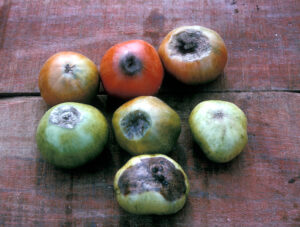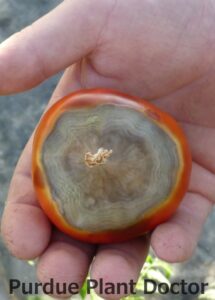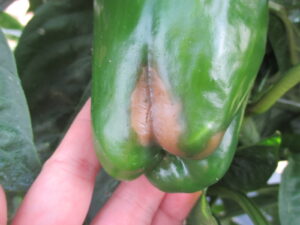Eager tomato growers, having lovingly nurtured their plants, anxiously await their ripe gems. But alas, a black, leathery spot appears at the base of the fruit.
Blossom end-rot is thankfully not an infectious disease, but rather a frustrating disorder of the fruit. The black scar tissue is thought to be caused by a deficiency of calcium in the developing fruit.
In most cases, blossom end-rot is brought on by extreme fluctuations in soil moisture. And this year we sure had extremes of rainfall, so blossom-end rot is likely to be prevalent.
The black or brown spot develops on the blossom-end of the fruit opposite the point of stem attachment, thus the name blossom-end rot. The scar is usually firm and leathery, although secondary rot organisms may enter through the damaged tissue, causing a soft rot to develop. Often it’s the early forming fruit that are affected, but it can happen anytime.
Tomatoes aren’t the only species affected by blossom-end rot; peppers, summer squash, and other cucurbit plants can also be afflicted.
There is no spray that will control blossom-end rot, except maybe from the irrigation hose. Some folks recommend spraying the plants with calcium, but by the time you see the scar on the fruit, it is too late. Most Indiana soils have plenty of calcium, although some sandy soils may be deficient.
Watering during dry spells and mulching to conserve soil moisture will help reduce the fluctuations in soil moisture and thus encourage steady growth and calcium supply in the fruits.
Although the fruits that have already developed the scar cannot be helped, the new developing fruits can be. You can cut away the affected portion of the fruit and use the rest, but avoid using any damaged fruits for canning.


